UP Lagoon and the Academic Oval: Difference between revisions
No edit summary |
mNo edit summary |
||
| (5 intermediate revisions by 3 users not shown) | |||
| Line 12: | Line 12: | ||
The sylvan Academic Oval in the heart of a bustling city is a sight to behold, appreciated most especially by those who frequent the campus. | The sylvan Academic Oval in the heart of a bustling city is a sight to behold, appreciated most especially by those who frequent the campus. | ||
The Academic Oval | The Academic Oval is the elliptical campus road marked by the various academic and administrative buildings composed of Quezon Hall, Vargas Museum, Faculty Center, Palma Hall, Gonzales Hall, Benitez Hall, Vinzons Hall, College of Business Administration building, School of Economics building, Malcolm Hall, National Engineering Center building, Melchor Hall, the University Theatre and Abelardo Hall. | ||
The Oval is made legendary by acacia trees, 164 as of the latest count that form a lush canopy around it. The acacia trees are as old as the Diliman campus itself, immediately upon transferring from Pade Faura, President Bienvenido Ma. Sioco Gonzales directed the planting of the acacia trees, to transform the campus from a field of cogon to a forest of trees. The man responsible for this beautification was Professor Jose Vera Santos. | The Oval is made legendary by its acacia trees, 164 as of the latest count that form a lush canopy around it. The acacia trees are as old as the Diliman campus itself, immediately upon transferring from Pade Faura, President Bienvenido Ma. Sioco Gonzales directed the planting of the acacia trees, to transform the campus from a field of cogon to a forest of trees. The man responsible for this beautification was Professor Jose Vera Santos. | ||
Through the years, the oval has stood as a silent witness to the various marches of students, faculty and staff, in exercise of their cherished freedom of oppression. It is also a convenient route for the Lantern Parade during the Christmas season. Back in the past, the hayride traversed the Oval to cap the Arbor Day celebration. | Through the years, the oval has stood as a silent witness to the various marches of students, faculty and staff, in exercise of their cherished freedom of oppression. It is also a convenient route for the Lantern Parade during the Christmas season. Back in the past, the hayride traversed the Oval to cap the Arbor Day celebration. | ||
Another University landmark that can be seen at the Academic Oval are the ikot jeepneys. The ikot, which made its campus appearance in 1955 | Another University landmark that can be seen at the Academic Oval are the ikot jeepneys. The ikot, which made its campus appearance in 1955, passes by the oval as it goes around campus to ferry passengers. Today, the ikot has its counterpart, the toki, which as the name implies, plies the counter route. | ||
The Oval is the staging place for many art events. In 1998, pedestrians hold the chance to view art installations of the fine arts students making | The Oval is the staging place for many art events. In 1998, pedestrians hold the chance to view art installations of the fine arts students making use of 24 of the acacia trees. The site-specific work, aptly titled 'Punong-puno ng Sining', dressed up the trees to represent the eight art forms of painting, sculpture, architecture, dance, literature, film, music, and theater. | ||
[[Image:Acad_oval.jpg|right|thumb|A bike lane near Melchor Hall]] | [[Image:Acad_oval.jpg|right|thumb|A bike lane near Melchor Hall]] | ||
In 1979, | In 1979, traffic lights were installed for a more orderly traffic along the Oval. To keep the campus as a haven for nature lovers, the Oval goes car-less on weekends, from 6 in the morning until 10 in the evening. The scheme enables joggers, bikers and families to enjoy the Oval and its surroundings free from the noise and the smoke pollutants belched out by motorized vehicles. | ||
The Alumni Walk was launched in U.P.’s centennial year in 2008. A project of the UPD administration under then Chancellor Sergio S. Cao, the project sought to transform the inner sidewalk of the Academic Oval into a tile-paved footpath with commemorative slabs bearing UPD alumni-donors’ names, and whose donations went to the UPD Faculty Development Fund. On March 2008, however, the Academic Oval was turned into one-way in order to lessen traffic volume entering the university. According to then Vice Chancellor for Community Affairs Cynthia Grace Gregorio, the policy also promotes lessening air pollution by creating biking lanes on the inner side of the circle. | The Alumni Walk was launched in U.P.’s centennial year in 2008. A project of the UPD administration under then Chancellor Sergio S. Cao, the project sought to transform the inner sidewalk of the Academic Oval into a tile-paved footpath with commemorative slabs bearing UPD alumni-donors’ names, and whose donations went to the UPD Faculty Development Fund. On March 2008, however, the Academic Oval was turned into one-way in order to lessen traffic volume entering the university. According to then Vice Chancellor for Community Affairs Cynthia Grace Gregorio, the policy also promotes lessening air pollution by creating biking lanes on the inner side of the circle. | ||
| Line 32: | Line 32: | ||
'''UPD Centennial Projects''' | '''UPD Centennial Projects''' | ||
The UPD Centennial Projects Committee has prepared eight major projects to mark UP’s 100th year. Chaired by UPD Chancellor Sergio Cao, the committee’s plans | The UPD Centennial Projects Committee has prepared eight major projects to mark UP’s 100th year. Chaired by UPD Chancellor Sergio Cao, the committee’s plans not only highlight the campus’ natural and physical resources. More importantly, they commemorate the university’s wealth of culture and talent. | ||
The project called “Luntiang Lagusan” will showcase UPD as environmentally friendly and ecologically sound with | The project called “Luntiang Lagusan” will showcase UPD as environmentally friendly and ecologically sound with the goal of promoting “campus civility”. On the forefront of this project is the improvement of street lighting and sidewalks along University Avenue to encourage walking and interaction among individuals. The plan also includes revitalizing the University Flower Seal and planting flora in the triangular area at the junction of the University and Commonwealth Avenues. | ||
| Line 44: | Line 44: | ||
[[Image:mainlib.jpg|left|thumb|Main Library in the 1950's]] | [[Image:mainlib.jpg|left|thumb|Main Library in the 1950's]] | ||
Gonzalez Hall was named after the University’s sixth President, Bienvenido M. Gonzalez (1939-1943, 1945-1951). The Main Library | Gonzalez Hall was named after the University’s sixth President, Bienvenido M. Gonzalez (1939-1943, 1945-1951). The Main Library completes the six pioneering buildings of the campus. It is the third building to be constructed next to the Benitez Hall and the Malcolm Hall, but is the first to be built as UP transferred from Padre Faura, Manila to Diliman in 1949. The five other buildings are namely Benitez Hall (College of Education), Palma Hall (College of Social Sciences and Philosophy), Malcolm Hall (College of Law), Melchor Hall (College of Engineering) and Quezon Hall (Administration Building). These buildings share and portray modern architectural designs, and also serve as landmarks of the University’s early beginnings, being part of its colorful history for the past one hundred years. | ||
'''''Beta Way''''' | '''''Beta Way''''' | ||
When the university moved in Diliman in 1949, the area was a spot in an adobe jungle. Except for the law and education buildings which were built just before the hostilities of WWII, the habitations consisted of Quonset huts left by the US Army which had bivouacked in the area. Soon permanent buildings were constructed around the Diliman quadrangle: the administration, library, engineering, liberal arts and some dormitories. Liberal Arts | When the university moved in Diliman in 1949, the area was a spot in an adobe jungle. Except for the law and education buildings which were built just before the hostilities of WWII, the habitations consisted of Quonset huts left by the US Army which had bivouacked in the area. Soon permanent buildings were constructed around the Diliman quadrangle: the administration, library, engineering, liberal arts and some dormitories. The Palma Hall (former Liberal Arts Building) and the Melchor Hall (Engineering building) buildings are mirror images of one another across the once marshy expanse, and engineering students wished for a short cut path between the two. For as always, engineering students had many liberal arts courses in the lower years of their curricula which they had to enrol in liberal arts: math, chemistry, physics, humanities, etc. | ||
It took the enterprising spirit of a Betan | It took the enterprising spirit of a Betan to blaze a passable gravel path across the mud and muck in 1952. The pathway was not straight for it had to seek the narrowest width of the water channel that drained the little valley that ran westward from the library building. Besides, there was the fifth hole of the U.P. Golf course right by the middle of the quadrangle. | ||
The "tentative" pathway, however, served its purpose, saving precious minutes to negotiate the long way from the third floor of the engineering building to the physics pavilion of Palma Hall. With the temporary gravel paving of the path being eroded during heavy downpours, the Betans made it a | The "tentative" pathway, however, served its purpose, saving precious minutes to negotiate the long way from the third floor of the engineering building to the physics pavilion of Palma Hall. With the temporary gravel paving of the path being eroded during heavy downpours, the Betans made it a task to repair the "Beta Way" during the work day on August 19 (a Quezon City holiday) each year. | ||
On the first day of the summer term 1961, April 11, the Betans staked out the centerline of the structure and right away started to work on the subgrade. By the end of summer, only short stretches on both sides of the creek and the culvert were yet to be done. The five-foot diameter concrete cylindrical pieces were acquired from a concrete pipe making outfit whose yard was seen from a the third floor offices of the DCCD Engineering at the Everlast building along Quezon Avenue. With the culvert installed, the project was finished in October except for the last red-colored paving block on the arts & sciences end. However, it was only in 1962 that the pathway was repaved in concrete. | |||
The original concrete-paved Beta Way was 240 meters long: 1. | It is more than 35 years since the inauguration of the Beta Way. Year after year, the Betans have been maintaining and making repairs of the pavements. The structure has been of great utility to the constituents of the University. | ||
The original concrete-paved Beta Way was 240 meters long: 1.58 meters wide. The total number of concrete hollow blocks for the inside borders, 1180; number of solid paving blocks, 3510. The total money spent, P204,290. Labor was free. When the parking lot was constructed in front of Palma Hall, thee length of the Beta Way was shortened, so the above statistics do not hold. This lane however has been of great utility all these years. | |||
| Line 66: | Line 68: | ||
- The western end of the oval is Kilometer 14 | - The western end of the oval is Kilometer 14 | ||
- The eastern end of the oval is Kilometer 15 | - The eastern end of the oval is Kilometer 15 | ||
- The Academic Oval is closed to all vehicles every Sunday | |||
==The Lagoon== | ==The Lagoon== | ||
| Line 75: | Line 76: | ||
[[Image:UP Lagoon - Fille.jpg|200px|thumb|some vegetation at the UP Lagoon - photo by Erika Fille (www.flickr.com/photos/erikafille)]] | [[Image:UP Lagoon - Fille.jpg|200px|thumb|some vegetation at the UP Lagoon - photo by Erika Fille (www.flickr.com/photos/erikafille)]] | ||
'''The UP Lagoon''' | '''The UP Lagoon''' | ||
More inward from the Quezon Hall is the UP Lagoon | More inward from the Quezon Hall is the UP Lagoon. The only body, no matter how small, of water found on campus. The lagoon dissects a vast expanse of land where several glades can be found. The area thus serves as a botanical reserve planted to narra, banaba, kapok, mahogany, royal, rubber, acacia and mango trees, and bamboo, among others. There was a time when flocks of sheep and other wild life would graze the area lending it a most pastoral scene on a lazy afternoon on campus. | ||
The lagoon itself is more than a meter deep. It is home to mudfish, catfish, tilapia, and a number of ducks that keeps on dwindling through the years. | The lagoon itself is more than a meter deep. It is home to mudfish, catfish, tilapia, and a number of ducks that keeps on dwindling through the years. | ||
The UP Lagoon looked differently decades ago. In the early 1950's, it was just a canal surrounded by tall grasses. Students never dared to go there for fear of snake bites. In the early 1970's the administration started to design plans to develop the lagoon. Concrete steps toward the beautification of the UP Lagoon, however, were not taken until the early 1990's. | The UP Lagoon looked differently decades ago. In the early 1950's, it was just a canal surrounded by tall grasses. Luckily, there was a development in the 1960s; it was modified to be a golf course. Students never dared to go there for fear of snake bites. In the early 1970's the administration started to design plans to develop the lagoon. Concrete steps toward the beautification of the UP Lagoon, however, were not taken until the early 1990's. | ||
| Line 92: | Line 90: | ||
Aside from the forest glades that adorn the area, the UP Lagoon is now landscaped with decorative plants complete with benches, tables, wooden bridges, and paved pathways with street lamps. The presence of the Beta Theatrum (courtesy of the Beta Epsilon Fraternity) in the area makes it an ideal activity center for cultural endeavors such as concerts and variety shows throughout the year. | Aside from the forest glades that adorn the area, the UP Lagoon is now landscaped with decorative plants complete with benches, tables, wooden bridges, and paved pathways with street lamps. The presence of the Beta Theatrum (courtesy of the Beta Epsilon Fraternity) in the area makes it an ideal activity center for cultural endeavors such as concerts and variety shows throughout the year. | ||
The Theatrum is Beta Epsilon's gift to the University on its Diamond Jubilee in 1983 during the term of MEB Renan Pineda BE 80. The architectural design was done by Dean Geronimo V. Manahan, BE 57, and the structural by Betan Engineers at DMCI. | The Theatrum is Beta Epsilon's gift to the University on its Diamond Jubilee in 1983 during the term of MEB Renan Pineda BE 80. The architectural design was done by Dean Geronimo V. Manahan, BE 57, and the structural by Betan Engineers at DMCI. Beta Epsilon has been a second home to the best and brightest from the U.P. College of Engineering. | ||
A ground breaking was held on August 27, 1983, with Chancellor E. G. Tabujara, Dean of Student Affairs Luis Beltran, Roni Manahan, Prof. I.I. Ilio, alumni and residents pitching in. Inauguration of the stage was on December 8, 1984. A capsule containing pertinent date about the frat and the structure was buried with the cornerstone. | A ground breaking was held on August 27, 1983, with Chancellor E. G. Tabujara, Dean of Student Affairs Luis Beltran, Roni Manahan, Prof. I.I. Ilio, alumni and residents pitching in. Inauguration of the stage was on December 8, 1984. A capsule containing pertinent date about the frat and the structure was buried with the cornerstone. | ||
[[Image:Lagoon1.JPG|200px|thumb|UP Lagoon at Present (2012) | [[Image:Lagoon1.JPG|200px|thumb|UP Lagoon at Present (2012)]] | ||
The main stage is situated by the water's edge. Across the lagoon is the audience area to be landscaped with rising steps towards Osmena Avenue. The first function to utilize this outdoor theater stage was the Poetry Reading of the works of Brod Dom I. It has also been used afterwards by the President's Cultural Committee. | The main stage is situated by the water's edge. Across the lagoon is the audience area to be landscaped with rising steps towards Osmena Avenue. The first function to utilize this outdoor theater stage was the Poetry Reading of the works of Brod Dom I. It has also been used afterwards by the President's Cultural Committee. | ||
[[Image:UP_Lagoon_ca_1950s.jpg| | [[Image:UP_Lagoon_ca_1950s.jpg|170px|thumb|left|UP Lagoon circa 1950s. Photo from [http://twitter.com/#!/regiesy/status/167249766210732034/photo/1 @regiesy on Twitter]] | ||
'''Tres Marias Plaza''' | '''Tres Marias Plaza''' | ||
Connecting the Amphitheater and the UP Lagoon is the Charter Donor's Garden with a sculpture perched atop a high pedestal at the center. | Connecting the Amphitheater and the UP Lagoon is the Charter Donor's Garden with a sculpture perched atop a high pedestal at the center. Without propensity to call people or places alternative names, the garden has acquired a nickname on account of the sculptural work:'' Tres Marias Plaza''. Entitled Three Women Sewing the First Philippine Flag, the polychrome work is by Napoleon Veloso Abueva. | ||
Napoleon Abueva is a Filipino artist. He is a sculptor given the distinction as the Philippines' National Artist for | Napoleon Abueva is a Filipino artist. He is a sculptor given the distinction as the Philippines' National Artist for scuplture. He is also entitled the "Father of Modern Philippine Sculpture". He is the only Boholano given the distinction as National Artist of the Philippines in the field of Visual Arts. His works have been executed using almost all kinds of materials, including hard wood like molave, acacia, langka wood, ipil, kamagong, palm wood and bamboo, adobe, metal, stainless steel, cement, marble, bronze, iron, alabaster, coral and brass. He even combines different materials, like wood with metal and stone. He graduated from the University of the Philippines School of Fine Arts in 1953 with a Bachelor of Fine Arts in sculpture. He was mentored by Guillermo Tolentino, the first National Artist for sculpture and creator of the UP Oblation. | ||
[[Image:Tresmarias.JPG|200px|thumb| | [[Image:Tresmarias.JPG|200px|thumb|right|Tres Marias statue found in between the lagoon and amphitheater.]] | ||
<blockquote> | <blockquote> | ||
| Line 120: | Line 118: | ||
The open area, picturesque landscape and airy atmosphere of the Amphitheater and the UP Lagoon | The open area, picturesque landscape, and airy atmosphere of the Amphitheater and the UP Lagoon combine tp make them a perfect place for picnics, dates, parties and even aerobics especially during the weekends. For nature lovers, however, the place is simply an oasis essential to contemplation and daydreaming. | ||
| Line 126: | Line 124: | ||
---- | ---- | ||
- | -PASYAL: Walking Around U.P. Diliman[http://uard.mainlib.upd.edu.ph/27/1/pasyal2.pdf]<br /> | ||
-Sites and Symbols, UP Diliman Library<br /> | -Sites and Symbols, UP Diliman Library<br /> | ||
-UP Calendar 1996<br /> | -UP Calendar 1996<br /> | ||
| Line 133: | Line 131: | ||
-Main library[http://www.mainlib.upd.edu.ph/?q=main-library][http://en.wikipilipinas.org/index.php?title=University_of_the_Philippines_Main_Library]<br /> | -Main library[http://www.mainlib.upd.edu.ph/?q=main-library][http://en.wikipilipinas.org/index.php?title=University_of_the_Philippines_Main_Library]<br /> | ||
-Beta Way[http://betaepsilon.org/BEinfra/bw1979.htm]<br /> | -Beta Way[http://betaepsilon.org/BEinfra/bw1979.htm]<br /> | ||
-Lagoon[http://www.univsource.com/words/lagoon-noun.htm]<br /> | -Lagoon[http://www.univsource.com/words/lagoon-noun.htm]<br /> [http://en.wikipilipinas.org/index.php?title=Lagoon] <br /> | ||
-The Beta Epsilon Theatrum and UP Lagoon Park Project[http://betaepsilon.org/2012-01Jan23-Betatheatrum/theatrumproject.htm]<br /> | -The Beta Epsilon Theatrum and UP Lagoon Park Project[http://betaepsilon.org/2012-01Jan23-Betatheatrum/theatrumproject.htm]<br /> | ||
-Napoleon Abueva[http://en.wikipedia.org/wiki/Napoleon_Abueva][http://www.kulay-diwa.com/napoleon_abueva]<br /> | -Napoleon Abueva[http://en.wikipedia.org/wiki/Napoleon_Abueva][http://www.kulay-diwa.com/napoleon_abueva]<br /> | ||
Latest revision as of 18:23, 8 October 2013
The Academic Oval

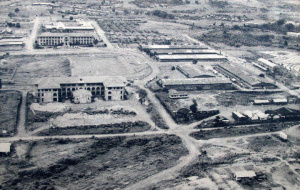
The University's academic highway, the Academic Oval covers a distance of 2.2 kilometers. The Oval starts at Quezon Hall, goes full circle towards the different colleges and units, and ends at Plaridel Hall.
The sylvan Academic Oval in the heart of a bustling city is a sight to behold, appreciated most especially by those who frequent the campus.
The Academic Oval is the elliptical campus road marked by the various academic and administrative buildings composed of Quezon Hall, Vargas Museum, Faculty Center, Palma Hall, Gonzales Hall, Benitez Hall, Vinzons Hall, College of Business Administration building, School of Economics building, Malcolm Hall, National Engineering Center building, Melchor Hall, the University Theatre and Abelardo Hall.
The Oval is made legendary by its acacia trees, 164 as of the latest count that form a lush canopy around it. The acacia trees are as old as the Diliman campus itself, immediately upon transferring from Pade Faura, President Bienvenido Ma. Sioco Gonzales directed the planting of the acacia trees, to transform the campus from a field of cogon to a forest of trees. The man responsible for this beautification was Professor Jose Vera Santos.
Through the years, the oval has stood as a silent witness to the various marches of students, faculty and staff, in exercise of their cherished freedom of oppression. It is also a convenient route for the Lantern Parade during the Christmas season. Back in the past, the hayride traversed the Oval to cap the Arbor Day celebration.
Another University landmark that can be seen at the Academic Oval are the ikot jeepneys. The ikot, which made its campus appearance in 1955, passes by the oval as it goes around campus to ferry passengers. Today, the ikot has its counterpart, the toki, which as the name implies, plies the counter route.
The Oval is the staging place for many art events. In 1998, pedestrians hold the chance to view art installations of the fine arts students making use of 24 of the acacia trees. The site-specific work, aptly titled 'Punong-puno ng Sining', dressed up the trees to represent the eight art forms of painting, sculpture, architecture, dance, literature, film, music, and theater.
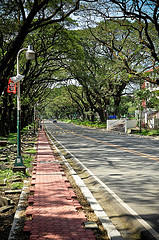
In 1979, traffic lights were installed for a more orderly traffic along the Oval. To keep the campus as a haven for nature lovers, the Oval goes car-less on weekends, from 6 in the morning until 10 in the evening. The scheme enables joggers, bikers and families to enjoy the Oval and its surroundings free from the noise and the smoke pollutants belched out by motorized vehicles.
The Alumni Walk was launched in U.P.’s centennial year in 2008. A project of the UPD administration under then Chancellor Sergio S. Cao, the project sought to transform the inner sidewalk of the Academic Oval into a tile-paved footpath with commemorative slabs bearing UPD alumni-donors’ names, and whose donations went to the UPD Faculty Development Fund. On March 2008, however, the Academic Oval was turned into one-way in order to lessen traffic volume entering the university. According to then Vice Chancellor for Community Affairs Cynthia Grace Gregorio, the policy also promotes lessening air pollution by creating biking lanes on the inner side of the circle.
UPD Centennial Projects
The UPD Centennial Projects Committee has prepared eight major projects to mark UP’s 100th year. Chaired by UPD Chancellor Sergio Cao, the committee’s plans not only highlight the campus’ natural and physical resources. More importantly, they commemorate the university’s wealth of culture and talent.
The project called “Luntiang Lagusan” will showcase UPD as environmentally friendly and ecologically sound with the goal of promoting “campus civility”. On the forefront of this project is the improvement of street lighting and sidewalks along University Avenue to encourage walking and interaction among individuals. The plan also includes revitalizing the University Flower Seal and planting flora in the triangular area at the junction of the University and Commonwealth Avenues.
Inside the Academic Oval
Main Library
The Main Library, which is the seat of library administration, is situated at Gonzalez Hall in the middle of the academic oval. It is organized into three major divisions which covers the various functional sections: (a) Technical Services Division which formulates and adopts standard acquisition, cataloging and indexing policies and procedures; (b) Administrative Services which provides support to the functional sections/units of the Library; and, (c) User Education and Services Division which lends books and provides reference, research and bibliographic services; maintains and preserve books, documents and archival materials; undertakes user education programs; and maintains computerized database applications. The Main Library is situated in the heart of the Academic Oval.
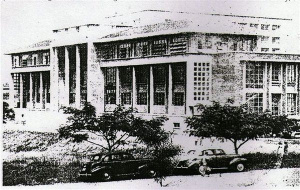
Gonzalez Hall was named after the University’s sixth President, Bienvenido M. Gonzalez (1939-1943, 1945-1951). The Main Library completes the six pioneering buildings of the campus. It is the third building to be constructed next to the Benitez Hall and the Malcolm Hall, but is the first to be built as UP transferred from Padre Faura, Manila to Diliman in 1949. The five other buildings are namely Benitez Hall (College of Education), Palma Hall (College of Social Sciences and Philosophy), Malcolm Hall (College of Law), Melchor Hall (College of Engineering) and Quezon Hall (Administration Building). These buildings share and portray modern architectural designs, and also serve as landmarks of the University’s early beginnings, being part of its colorful history for the past one hundred years.
Beta Way
When the university moved in Diliman in 1949, the area was a spot in an adobe jungle. Except for the law and education buildings which were built just before the hostilities of WWII, the habitations consisted of Quonset huts left by the US Army which had bivouacked in the area. Soon permanent buildings were constructed around the Diliman quadrangle: the administration, library, engineering, liberal arts and some dormitories. The Palma Hall (former Liberal Arts Building) and the Melchor Hall (Engineering building) buildings are mirror images of one another across the once marshy expanse, and engineering students wished for a short cut path between the two. For as always, engineering students had many liberal arts courses in the lower years of their curricula which they had to enrol in liberal arts: math, chemistry, physics, humanities, etc.
It took the enterprising spirit of a Betan to blaze a passable gravel path across the mud and muck in 1952. The pathway was not straight for it had to seek the narrowest width of the water channel that drained the little valley that ran westward from the library building. Besides, there was the fifth hole of the U.P. Golf course right by the middle of the quadrangle.
The "tentative" pathway, however, served its purpose, saving precious minutes to negotiate the long way from the third floor of the engineering building to the physics pavilion of Palma Hall. With the temporary gravel paving of the path being eroded during heavy downpours, the Betans made it a task to repair the "Beta Way" during the work day on August 19 (a Quezon City holiday) each year.
On the first day of the summer term 1961, April 11, the Betans staked out the centerline of the structure and right away started to work on the subgrade. By the end of summer, only short stretches on both sides of the creek and the culvert were yet to be done. The five-foot diameter concrete cylindrical pieces were acquired from a concrete pipe making outfit whose yard was seen from a the third floor offices of the DCCD Engineering at the Everlast building along Quezon Avenue. With the culvert installed, the project was finished in October except for the last red-colored paving block on the arts & sciences end. However, it was only in 1962 that the pathway was repaved in concrete.
It is more than 35 years since the inauguration of the Beta Way. Year after year, the Betans have been maintaining and making repairs of the pavements. The structure has been of great utility to the constituents of the University.
The original concrete-paved Beta Way was 240 meters long: 1.58 meters wide. The total number of concrete hollow blocks for the inside borders, 1180; number of solid paving blocks, 3510. The total money spent, P204,290. Labor was free. When the parking lot was constructed in front of Palma Hall, thee length of the Beta Way was shortened, so the above statistics do not hold. This lane however has been of great utility all these years.
Some trivias:
- There is a total of 16 humps along the oval. - The lamp posts around the oval light up at 6 p.m. - The western end of the oval is Kilometer 14 - The eastern end of the oval is Kilometer 15 - The Academic Oval is closed to all vehicles every Sunday
The Lagoon
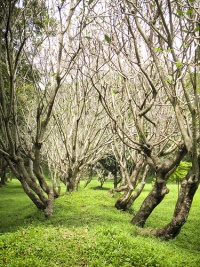
The UP Lagoon
More inward from the Quezon Hall is the UP Lagoon. The only body, no matter how small, of water found on campus. The lagoon dissects a vast expanse of land where several glades can be found. The area thus serves as a botanical reserve planted to narra, banaba, kapok, mahogany, royal, rubber, acacia and mango trees, and bamboo, among others. There was a time when flocks of sheep and other wild life would graze the area lending it a most pastoral scene on a lazy afternoon on campus.
The lagoon itself is more than a meter deep. It is home to mudfish, catfish, tilapia, and a number of ducks that keeps on dwindling through the years.
The UP Lagoon looked differently decades ago. In the early 1950's, it was just a canal surrounded by tall grasses. Luckily, there was a development in the 1960s; it was modified to be a golf course. Students never dared to go there for fear of snake bites. In the early 1970's the administration started to design plans to develop the lagoon. Concrete steps toward the beautification of the UP Lagoon, however, were not taken until the early 1990's.
Beta Epsilon Theatrum
Aside from the forest glades that adorn the area, the UP Lagoon is now landscaped with decorative plants complete with benches, tables, wooden bridges, and paved pathways with street lamps. The presence of the Beta Theatrum (courtesy of the Beta Epsilon Fraternity) in the area makes it an ideal activity center for cultural endeavors such as concerts and variety shows throughout the year.
The Theatrum is Beta Epsilon's gift to the University on its Diamond Jubilee in 1983 during the term of MEB Renan Pineda BE 80. The architectural design was done by Dean Geronimo V. Manahan, BE 57, and the structural by Betan Engineers at DMCI. Beta Epsilon has been a second home to the best and brightest from the U.P. College of Engineering.
A ground breaking was held on August 27, 1983, with Chancellor E. G. Tabujara, Dean of Student Affairs Luis Beltran, Roni Manahan, Prof. I.I. Ilio, alumni and residents pitching in. Inauguration of the stage was on December 8, 1984. A capsule containing pertinent date about the frat and the structure was buried with the cornerstone.
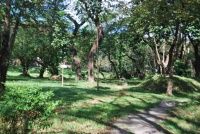
The main stage is situated by the water's edge. Across the lagoon is the audience area to be landscaped with rising steps towards Osmena Avenue. The first function to utilize this outdoor theater stage was the Poetry Reading of the works of Brod Dom I. It has also been used afterwards by the President's Cultural Committee.

Tres Marias Plaza
Connecting the Amphitheater and the UP Lagoon is the Charter Donor's Garden with a sculpture perched atop a high pedestal at the center. Without propensity to call people or places alternative names, the garden has acquired a nickname on account of the sculptural work: Tres Marias Plaza. Entitled Three Women Sewing the First Philippine Flag, the polychrome work is by Napoleon Veloso Abueva.
Napoleon Abueva is a Filipino artist. He is a sculptor given the distinction as the Philippines' National Artist for scuplture. He is also entitled the "Father of Modern Philippine Sculpture". He is the only Boholano given the distinction as National Artist of the Philippines in the field of Visual Arts. His works have been executed using almost all kinds of materials, including hard wood like molave, acacia, langka wood, ipil, kamagong, palm wood and bamboo, adobe, metal, stainless steel, cement, marble, bronze, iron, alabaster, coral and brass. He even combines different materials, like wood with metal and stone. He graduated from the University of the Philippines School of Fine Arts in 1953 with a Bachelor of Fine Arts in sculpture. He was mentored by Guillermo Tolentino, the first National Artist for sculpture and creator of the UP Oblation.
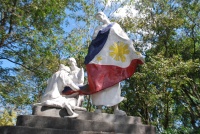
Several of his public art can also be found at UP Diliman:
-1957: Crucifix with two corpora, at the Parish of the Holy Sacrifice
-1962: University Gateway (also UP Gates)
-1967: Tribute to Higher Education, at the entrance of University Avenue
-1979: The Spirit of Business, in front of the College of Business Administration
-1992: Diwata, at the Faculty Center
-1996: Alma Mater, at the lobby of Ang Bahay ng Alumni
-1996: Three Women Sewing the First Philippine Flag, also known as Tres Marias Plaza, at the UP Donors' Garden, as part of the centennial celebration of the 1986 Philippine Revolution
The open area, picturesque landscape, and airy atmosphere of the Amphitheater and the UP Lagoon combine tp make them a perfect place for picnics, dates, parties and even aerobics especially during the weekends. For nature lovers, however, the place is simply an oasis essential to contemplation and daydreaming.
Sources
-PASYAL: Walking Around U.P. Diliman[1]
-Sites and Symbols, UP Diliman Library
-UP Calendar 1996
-University of the Philippines Diliman, The Oblation and Academic Oval[2]
-UPD Centennial Projects[3]
-Main library[4][5]
-Beta Way[6]
-Lagoon[7]
[8]
-The Beta Epsilon Theatrum and UP Lagoon Park Project[9]
-Napoleon Abueva[10][11]


